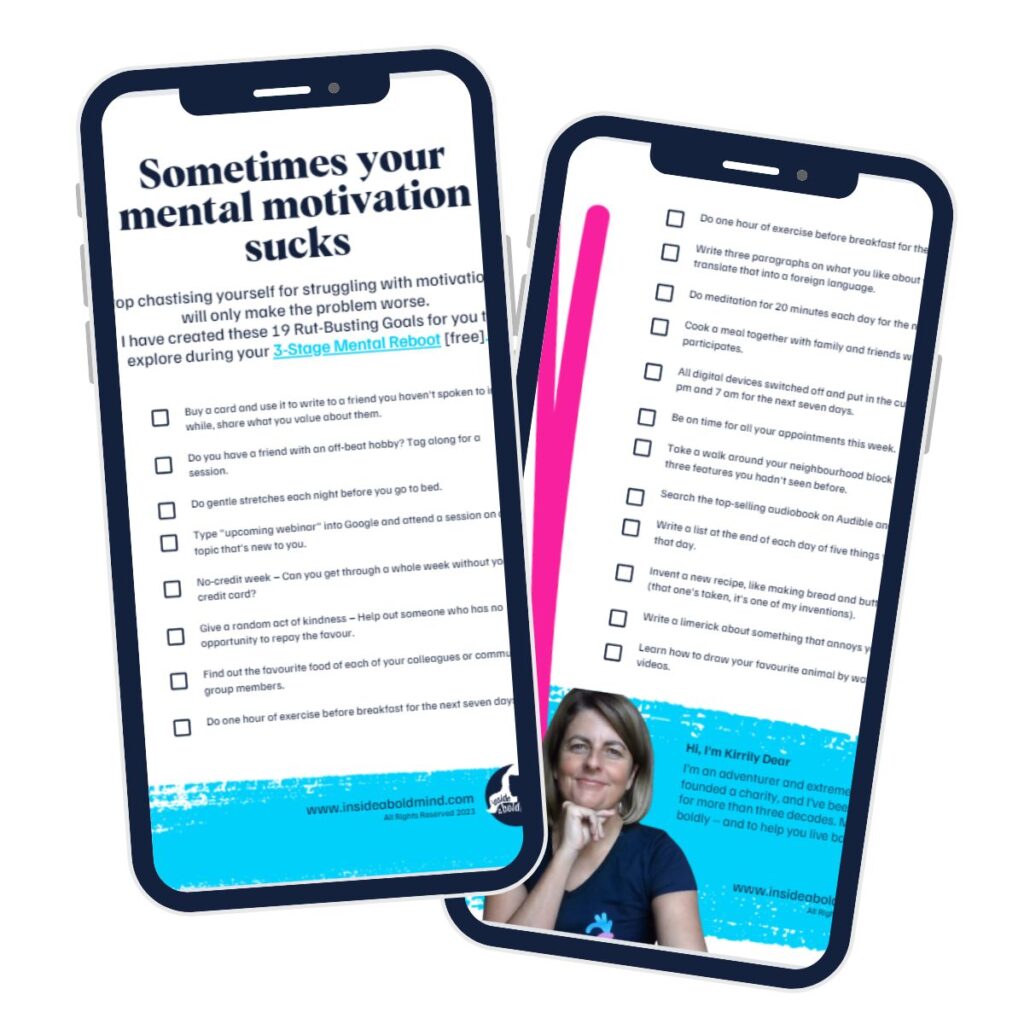Sometimes Your Mental Motivation Sucks
Stop chastising yourself for struggling with motivation; it won’t change the outcome. If you want get moving again, plicate the stubborn mule inside your mind.
“I’m stuck in a rut.”
I’ve heard those words frequently in recent weeks as many people struggle with motivation. We’re halfway through a year in which the need to pivot, adapt and dig deep continues to escalate.
One woman I spoke with is recovering from a short stint in hospital. Before entering the hospital, she created a bucket list of fun activities for when she recovered. She’s got the all-clear from her doctor to start ticking items off that list, but, in her words, she “just can’t seem to get started”.
Another woman had developed a nasty reaction to Microsoft Word. She wants to update her CV and apply for a new job, but her mind goes blank whenever she looks at the flashing cursor on a page.
These women have busy lives and are well-accustomed to achieving goals. They’re neither lazy nor expect life to hand them riches on a silver platter. So why can’t they take these relatively simple and beneficial actions?
The “Rut” Is A Mental Energy Deficit
I like to explain the concept of a mental energy deficit by comparing a car with a mule.
A car’s engine is the source of its power, and fuel is required in the tank to keep the engine humming. A car’s tank (or battery!) can carry a finite amount of fuel; when that gets low, you must stop and refuel.
In many ways, your brain is the same as a car. Moment-to-moment it has a finite level of resources available for thinking, and when those resources run out, your thinking ability stops. A mental energy deficit is when the tank’s fuel level is less than you need for the journey.
However, your brain is more intelligent than a car, and that’s where the mule comes into the picture.
Your Brain Behaves Like A Mule
Mules are intelligent and stubborn. They will walk for days to drink at their favourite water hole but refuse to walk 100m down a track if there’s no good reason. Mules choose to conserve effort for activities that they believe most benefit them.
Your brain behaves similarly. Before launching into a task, it will assess the mental effort required against the gain to determine if it is willing and able to invest the energy.
Two categories of mental tasks are more likely to fail the Mule Test in your mind.
1. Complex thinking without obvious personal reward
For instance, try solving a problem that isn’t important to you, or you didn’t create it and watch your mental motivation dive. This is common in workplaces where issues get delegated to others and land in the mental too-hard basket.
2. Extrinsically motivated tasks
These are big energy suckers, so you’re unlikely to reach your destination unless your tank is full. Some examples include studying to get good grades because someone said you must. Ask any student how much effort that takes!
Anything motivated by the desire to impress others, for social status, or to prove yourself. Your conscious mind might think these are desirable outcomes, but your non-conscious mind says otherwise, and its command is central to the allocation of resources.
A favourable cost-benefit trade-off (i.e., the task benefits are sufficient given the actual mental energy costs) will result in mental energy replenishment, whereas an unfavourable trade-off (i.e., the task benefits are insufficient given the actual mental energy costs) will not result in mental energy replenishment.
In the latter case, the mental energy deficit acts as a signal that effort is being poorly invested and that corrective action should be taken (e.g., disengage from task, update priors about the mental energy requirements for the type of task performed, rest).
Wang et al 2021 [1]
If you need more convincing, test the flipside of these and see the impact on your ability to focus. Think about times when you have worked on something vital to you personally that brings you joy and fulfilment.
As the expression goes, find a job you love, and you’ll never work another day. That’s mental motivation at its best, where the perceived benefit far exceeds the mental effort required for the journey.

How To Dig Yourself Out
Let’s go back to the two women I mentioned earlier; one is struggling to get started with her bucket list, and the other is procrastinating about writing her CV.
Both women had tried to dig themselves out of their motivation rut using common tactics, but these failed to deliver the desired result.
Fail #1: Give yourself a stiff talking
You might dig those mental spurs in, tell yourself that you’re lazy, to harden up, that everyone will think you’re dumb if you can’t do XYZ.
Negative self-talk does more damage than good because it harms your confidence and confirms to the mule in your mind that the task you want to do is all pain, no gain.
Fail #2: Take a huge dose of caffeine and blast it
This could work, but it will burn more mental energy than a V8 engine. Our CV writer has tried an approach like this, but each time, she would start on the task and then get distracted by something else.
Fail #3: Do it all for them❤️
Altruism is lovely, so you might stick a photo of your family, dog or customer on your desk and tell yourself you’re doing it all for them. However, it will put an enormous demand on your mental energy stores unless you’re clear about how you benefit.
Our hospital woman is a natural giver, and when she reviewed her bucket list, she noticed many activities were about giving joy and happiness to other people. There wasn’t much on there that was purely about her.
If these common tactics fail, what works? I’m glad you asked.
Here’s A 3-Stage Mental Reboot
I suggest doing this process over three weeks but give yourself some flexibility. If you find a specific activity rewarding, play longer with it and explore it more deeply.
(If you don’t have three weeks, try the 2-Minute Motivation Rejuvenator.)
Stage 1: Meet your mind in the mode that it is in
Write in a journal for 15 minutes or so to understand your mind’s current mood and energy levels. You want your inner mule to feel loved, seen and accepted.
Some points to explore in your journal:
- What aspects of me do I love the most?
- Write all the thoughts that are churning in your mind
- I’m grateful for my… (list personal attributes)
- How have you invested in mental effort recently? (Recognise the work you have done and why your tank may be empty)
- List words that describe your mental mood each day
Stage 2: Take your mind on a staycation
We go on vacations to rejuvenate energy and to recognise there’s a bigger world out there. A mental staycation has the same benefits. Mentally travel far away from your cognitive normal to help refuel your tank.
- Review your long to-do list and shorten it to no more than three important-to-you-personally tasks.
- If you’re indoors a lot, go outdoors and do a walking meditation to connect with and observe the world around you.
- Do you mainly do logical, rational thinking? Stagger your workplan and create three 15-min slots each day for creative work like therapeutic colouring. If you can, dedicate a whole day or week to predominantly creative activities.
- Yoga, qi gong, tai chi, and meditation are all winners for refuelling your mental tank.
- Healthy eating, sleeping and moderate exercise are always beneficial and a fantastic boost if they’re not part of your daily routine.
People often attribute sluggishness and procrastination to adrenal fatigue; an over-stimulation of the adrenal system caused by stress. Research currently doesn’t support the existence of the condition.
“This systematic review proves that there is no substantiation that “adrenal fatigue” is an actual medical condition. Therefore, adrenal fatigue is still a myth.”
Cadegiani FA, Kater CE. [2]
Stage 3: Regain momentum
It’s time to get focused on goals again but change the way you set goals using the principles above.
Quick goals that are personally rewarding will fuel your mental energy reserve rather than draining from it. I’ve created 19 x 1-Week Goals to help you think of possibilities.
Use this same principle to break big goals down into enjoyable milestones.
For example, let’s say there’s a report you must write for work, and you’ve procrastinated about it for weeks. Now the deadline is looming.
Start by writing your plan for getting the report done. There might be a research phase, collating results, drafting, reviewing, and finalising. Each of these becomes your short-term goal and wins.
Now bring the personal reward into your plan. Research phase? Perhaps it’s an opportunity to delve into a subject area that interests you or interview people you’ve wanted to talk to for ages. Drafting? Can that be done in a serene location with some soul-enriching you-time?
You get the drift. Almost every task can have fun and rewarding elements if you search for it. The important thing is to make those personal rewards conscious and a high priority so that your goal-setting passes the Mule Test.
Reach out if you need help doing any of this.

[1] Wang, X., Janiszewski, C., Zheng, Y., Laran, J., & Jang, W. E. (2021). Deriving Mental Energy From Task Completion. Frontiers in Psychology, 12, 717414. https://doi.org/10.3389/fpsyg.2021.717414
[2] Cadegiani FA, Kater CE. Adrenal fatigue does not exist: a systematic review. BMC Endocr Disord. 2016 Aug 24;16(1):48. doi: 10.1186/s12902-016-0128-4. Erratum in: BMC Endocr Disord. 2016 Nov 16;16(1):63. PMID: 27557747; PMCID: PMC4997656.




